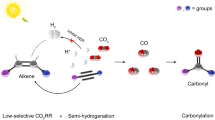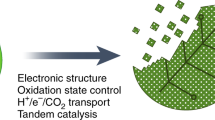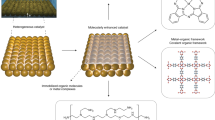Abstract
The problem with current state-of-the-art catalysts for CO2 photo- or electroreduction is rooted in the notion that no single system can independently control, and thus optimize, the interplay between activity, selectivity and efficiency. At its core, reticular chemistry is recognized for its ability to control, with atomic precision, the chemical and structural features (activity and selectivity) as well as the output optoelectronic properties (efficiency) of porous, crystalline materials. The molecular building blocks that are in a reticular chemist’s toolbox are chosen in such a way that the structures are rationally designed, framework chemistry is performed to integrate catalytically active components, and the manner in which these building blocks are connected endows the material with the desired optoelectronic properties. The fact that these aspects can be fine-tuned independently lends credence to the prospect of reticular chemistry contributing to the design of next-generation CO2 reduction catalysts.
This is a preview of subscription content, access via your institution
Access options
Access Nature and 54 other Nature Portfolio journals
Get Nature+, our best-value online-access subscription
$29.99 / 30 days
cancel any time
Subscribe to this journal
Receive 12 print issues and online access
$259.00 per year
only $21.58 per issue
Buy this article
- Purchase on Springer Link
- Instant access to full article PDF
Prices may be subject to local taxes which are calculated during checkout




Similar content being viewed by others
Change history
07 August 2018
In the version of this Perspective originally published, the titles of the references were missing; the online versions have now been amended to include them.
References
Concepcion, J. J., House, R. L., Papanikolas, J. M. & Meyer, T. J. Chemical approaches to artificial photosynthesis. Proc. Natl Acad. Sci. USA 109, 15560–15564 (2012).
Liu, C., Colón, B. C., Ziesack, M., Silver, P. A. & Nocera, D. G. Water splitting-biosynthetic system with CO2 reduction efficiencies exceeding photosynthesis. Science 352, 1210–1213 (2016).
Sakimoto, K. K., Wong, A. B. & Yang, P. Self-photosensitization of nonphotosynthetic bacteria for solar-to-chemical production. Science 351, 74–77 (2016).
White, J. L. et al. Light-driven heterogeneous reduction of carbon dioxide: photocatalysts and photoelectrodes. Chem. Rev. 115, 12888–12935 (2015).
Seh, Z. W. et al. Combining theory and experiment in electrocatalysis: Insights into materials design. Science 355, eaad4998 (2017).
Chen, Y., Li, C. W. & Kanan, M. W. Aqueous CO2 reduction at very low overpotential on oxide-derived Au nanoparticles. J. Am. Chem. Soc. 134, 19969–19972 (2012).
Kim, D., Resasco, J., Yu, Y., Asiri, A. M. & Yang, P. Synergistic geometric and electronic effects for electrochemical reduction of carbon dioxide using gold-copper bimetallic nanoparticles. Nat. Commun. 5, 4948 (2014).
Cao, Z. et al. A molecular surface functionalization approach to tuning nanoparticle electrocatalysts for carbon dioxide reduction. J. Am. Chem. Soc. 138, 8120–8125 (2016).
Domen, K. & Hisatomi, T. Introductory lecture: Sunlight-driven water splitting and carbon dioxide reduction by heterogeneous semiconductor systems as key processes in artificial photosynthesis. Faraday Discuss. 198, 11–35 (2017).
Morris, A. J., Meyer, G. J. & Fujita, E. Molecular approaches to the photocatalytic reduction of carbon dioxide for solar fuels. Acc. Chem. Res. 42, 1983–1994 (2009).
Costentin, C., Passard, G., Robert, M. & Savéant, J.-M. Ultraefficient homogeneous catalyst for the CO2-to-CO electrochemical conversion. Proc. Natl Acad. Sci. USA 111, 14990–14994 (2014).
Costentin, C., Drouet, S., Robert, M. & Savéant, J.-M. A local proton source enhances CO2 electroreduction to CO by a molecular Fe catalyst. Science 338, 90–94 (2012).
Rajeshwar, K., Thomas, A. & Janáky, C. Photocatalytic activity of inorganic semiconductor surfaces: Myths, hype, and reality. J. Phys. Chem. Lett. 6, 139–147 (2015).
Furukawa, H., Cordova, K. E., O’Keeffe, M. & Yaghi, O. M. The chemistry and applications of metal-organic frameworks. Science 341, 1230444 (2013).
Diercks, C. S. & Yaghi, O. M. The atom, the molecule, and the covalent organic framework. Science 355, eaal1585 (2017).
Lee, J. et al. Metal-organic framework materials as catalysts. Chem. Soc. Rev. 38, 1450–1459 (2009).
Zhang, T. & Lin, W. Metal-organic frameworks for artificial photosynthesis and photocatalysis. Chem. Soc. Rev. 43, 5982–5993 (2014).
Farha, O. K. et al. Metal-organic framework materials with ultrahigh surface areas: Is the sky the limit? J. Am. Chem. Soc. 134, 15016–15021 (2012).
Deng, H. et al. Large-pore apertures in a series of metal-organic frameworks. Science 336, 1018–1023 (2012).
Sun, L., Campbell, M. G. & Dincă, M. Electrically conductive porous metal-organic frameworks. Angew. Chem. Int. Ed. 55, 3566–3579 (2016).
Guo, J. et al. Conjugated organic framework with three-dimensionally ordered stable structure and delocalized π clouds. Nat. Commun. 4, 2736 (2013).
Berardi, S. et al. Molecular artificial photosynthesis. Chem. Soc. Rev. 43, 7501–7519 (2014).
Wang, C., Xie, Z., deKrafft, K. E. & Lin, W. Doping metal-organic frameworks for water oxidation, carbon dioxide reduction, and organic photocatalysis. J. Am. Chem. Soc. 133, 13445–13454 (2011).
Hawecker, J., Lehn, J.-M. & Ziessel, R. Photochemical and electrochemical reduction of carbon dioxide to carbon monoxide mediated by (2,2’-bipyridine)tricarbonylchlororhenium(I) and related complexes as homogeneous catalysts. Helv. Chim. Acta 69, 1990–2012 (1986).
Keith, J. A., Grice, K. A., Kubiak, C. P. & Carter, E. A. Elucidation of the selectivity of proton-dependent electrocatalytic CO2 reduction by fac-Re(bpy)(CO)3Cl. J. Am. Chem. Soc. 135, 15823–15829 (2013).
Ryu, U. J. et al. Synergistic interaction of Re complex and amine functionalized multiple ligands in metal-organic frameworks for conversion of carbon dioxide. Sci. Rep. 7, 612 (2017).
Wang, D., Huang, R., Liu, W., Sun, D. & Li, Z. Fe-based MOFs for photocatalytic CO2 reduction: Role of coordination unsaturated sites and dual excitation pathways. ACS Catal. 4, 4254–4260 (2014).
Whitfield, T. R., Wang, X., Liu, L. & Jacobson, A. J. Metal-organic frameworks based on iron oxide octahedral chains connected by benzenedicarboxylate dianions. Solid State Sci. 7, 1096–1103 (2005).
Surblé, S., Serre, C., Mellot-Draznieks, C., Millangea, F. & Férey, G. A new isoreticular class of metal-organic frameworks with the MIL-88 topology. Chem. Commun. 0, 284–286 (2008).
Chen, D., Xing, H., Wang, C. & Su, Z. Highly efficient visible-light-driven CO2 reduction to formate by a new anthracene-based zirconium MOF via dual catalytic routes. J. Mater. Chem. A 4, 2657–2662 (2016).
Doan, T. L. H. et al. Tailoring the optical absorption of water-stable Zr(IV)- and Hf(IV)-based metal-organic framework photocatalysts. Chem. Asian J. 10, 2660–2668 (2015).
Nasalevich, M. A. et al. Electronic origins of photocatalytic activity in d 0 metal organic frameworks. Sci. Rep. 6, 23676 (2016).
Dan-Hardi, M. et al. A new photoactive crystalline highly porous titanium(IV) dicarboxylate. J. Am. Chem. Soc. 131, 10857–10859 (2009).
Fu, Y. et al. An amine-functionalized titanium metal-organic framework photocatalyst with visible light-induced activity for CO2 reduction. Angew. Chem. Int. Ed. 124, 3420–3423 (2012).
Hendon, C. H. et al. Engineering the optical response of the titanium-MIL-125 metal-organic framework through ligand functionalization. J. Am. Chem. Soc. 135, 10942–10945 (2013).
Logan, M. W. et al. Systematic variation of the optical bandgap in titanium based isoreticular metal-organic frameworks for photocatalytic reduction of CO2 under blue light. J. Mater. Chem. A 5, 11854–11863 (2017).
Khaletskaya, K. et al. Fabrication of gold/titania photocatalyst for CO2 reduction based on pyrolytic conversion of the metal-organic framework NH2-MIL-125(Ti) loaded with gold nanoparticles. Chem. Mater. 27, 7248–7257 (2015).
Li, R. et al. Integration of an inorganic semiconductor with a metal-organic framework: A platform for enhanced gaseous photocatalytic reactions. Adv. Mater. 26, 4783–4788 (2014).
Choi, K. M. et al. Plasmon-enhanced photocatalytic CO2 conversion within metal-organic frameworks under visible light. J. Am. Chem. Soc. 139, 356–362 (2017).
Fei, H., Sampson, M. D., Lee, Y., Kubiak, C. P. & Cohen, S. M. Photocatalytic CO2 reduction to formate using a Mn(I) molecular catalyst in a robust metal-organic framework. Inorg. Chem. 54, 6821–6828 (2015).
Riplinger, C., Sampson, M. D., Ritzmann, A. M., Kubiak, C. P. & Carter, E. A. Mechanistic contrasts between manganese and rhenium bipyridine electrocatalysts for the reduction of carbon dioxide. J. Am. Chem. Soc. 136, 16285–16298 (2014).
Lee, Y., Kim, S., Kang, J. K. & Cohen, S. M. Photocatalytic CO2 reduction by a mixed metal (Zr/Ti), mixed ligand metal-organic framework under visible light irradiation. Chem. Commun. 51, 5735–5738 (2015).
Darago, L. E., Aubrey, M. L., Yu, C. J., Gonzalez, M. I. & Long, J. R. Electronic conductivity, ferromagnetic ordering, and reductive insertion mediated by organic mixed-valence in a ferric semiquinoid metal-organic framework. J. Am. Chem. Soc. 137, 15703–15711 (2015).
Clough, A. J. et al. Metallic conductivity in a two-dimensional cobalt dithiolene metal-organic framework. J. Am. Chem. Soc. 139, 10863–10867 (2017).
Sheberla, D. et al. High electrical conductivity in Ni3(2,3,6,7,10,11-hexaiminotriphenylene)2, a semiconductivity metal-organic graphene analogue. J. Am. Chem. Soc. 136, 8859–8862 (2014).
Sun, L. et al. Is iron unique in promoting electrical conductivity in MOFs? Chem. Sci. 8, 4450–4457 (2017).
Janssen, R. A. J. & Nelson, J. Factors limiting device efficiency in organic photovoltaics. Adv. Mater. 25, 1847–1858 (2013).
Hendon, C. H., Rieth, A. J., Korzynski, M. D. & Dinca, M. Grand challenges and future opportunities for metal-organic frameworks. ACS Cent. Sci. 3, 554–563 (2017).
Trickett, C. A. et al. The chemistry of metal-organic frameworks for CO2 capture, regeneration, and conversion. Nat. Rev. Mater. 2, 17045 (2017).
Xiao, D. J. et al. Oxidation of ethane to ethanol by N2O in a metal-organic framework with coordinatively unsaturated iron(II) sites. Nat. Chem. 6, 590–595 (2014).
Metzger, E. D., Comito, R. J., Hendon, C. H. & Dincă, M. Mechanism of single-site molecule-like catalytic ethylene dimerization in Ni-MFU-4l. J. Am. Chem. Soc. 139, 757–762 (2017).
Costentin, C., Robert, M. & Savéant, J.-M. Catalysis of the electrochemical reduction of carbon dioxide. Chem. Soc. Rev. 42, 2423–2436 (2013).
Morris, W. et al. Synthesis, structure, and metalation of two new highly porous zirconium metal-organic frameworks. Inorg. Chem. 51, 6443–6445 (2012).
Hod, I. et al. Fe-porphyrin-based metal-organic framework films as high-surface concentration, heterogeneous catalysts for electrochemical reduction of CO2. ACS Catal. 5, 6302–6309 (2015).
Fateeva, A. et al. A water-stable porphyrin-based metal-organic framework active for visible-light photocatalysis. Angew. Chem. Int. Ed. 51, 7440–7444 (2012).
Kornienko, N. et al. Metal-organic frameworks for electrocatalytic reduction of carbon dioxide. J. Am. Chem. Soc. 137, 14129–14135 (2015).
Wan, S. et al. Covalent organic frameworks with high charge carrier mobility. Chem. Mater. 23, 4094–4097 (2011).
Lin, S. et al. Covalent organic frameworks comprising cobalt porphyrins for catalytic CO2 reduction in water. Science 349, 1208–1213 (2015).
Mac Dowell, N., Fennell, P. S., Shah, N. & Maitland, G. C. The role of CO2 capture and utilization in mitigating climate change. Nat. Clim. Change 7, 243–249 (2017).
Acknowledgements
We would like to acknowledge Saudi Aramco (ORCP2390) for their continued collaboration and support. C.S.D. would like to acknowledge the Kavli Foundation for support through the Kavli Energy NanoScience Institute Philomathia graduate student fellowship. Y.L. is supported by the graduate student fellowship in the environmental sciences provided by the Philomathia Center. K.E.C. is grateful for discussions with A. Jamal (Saudi Aramco) during the preliminary stages of this manuscript. Finally, we acknowledge M. Prevot (UC Berkeley) for helpful discussions.
Author information
Authors and Affiliations
Contributions
K.E.C. and O.M.Y. conceived the general idea behind this Perspective. C.S.D. and K.E.C. wrote the manuscript under the mentorship of O.M.Y. Y.L. aided in figure creation. The manuscript was written through contributions of all authors. All authors have given approval to the final version of the manuscript.
Corresponding author
Ethics declarations
Competing interests
The authors declare no competing interests.
Additional information
Publisher’s note: Springer Nature remains neutral with regard to jurisdictional claims in published maps and institutional affiliations.
Rights and permissions
About this article
Cite this article
Diercks, C.S., Liu, Y., Cordova, K.E. et al. The role of reticular chemistry in the design of CO2 reduction catalysts. Nature Mater 17, 301–307 (2018). https://doi.org/10.1038/s41563-018-0033-5
Received:
Accepted:
Published:
Issue Date:
DOI: https://doi.org/10.1038/s41563-018-0033-5
This article is cited by
-
Comparative analysis of scaled entropies and topological properties of triphenylene-based metal and covalent organic frameworks
Chemical Papers (2024)
-
Promoted surface charge density from interlayer Zn–N4 configuration in carbon nitride for enhanced CO2 photoreduction
Nano Research (2024)
-
Bi2S3 nanofiber bunch for highly efficient CO2 electroreduction to formate at low overpotential
Rare Metals (2024)
-
Room-temperature photosynthesis of propane from CO2 with Cu single atoms on vacancy-rich TiO2
Nature Communications (2023)
-
Designing reliable and accurate isotope-tracer experiments for CO2 photoreduction
Nature Communications (2023)



